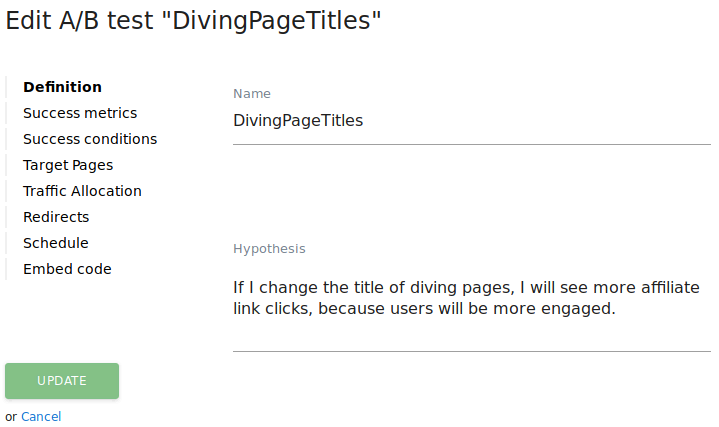

Apr
Matomo A/B Testing Complete Guide
Matomo A/B testing that is often referred to as split testing, is the experiment of comparing two web pages, app or content against each other to estimate the better performance between the two. It is a useful Matomo feature, utilized in web development and digital marketing for testing the impact of change in a small headline, button, design, content or thorough functionalities of web pages to grasp their influence on user behavior, experience and conversions. We can compare the performance of each variation against a specific metric such as click-through rates, conversion rates, or time on site for deriving desired outcome goals.
Setting Up A/B Testing Experiments in Matomo
Requirements and prerequisites:
- First of all, you should have Matomo for getting started with A/B testing.
- Install and activate this premium plugin on your Matomo Instance.
- Make adjustments to your website code to integrate the A/B test.
- Clearly define the metrics you want to test.
Install and Activate A/B Testing Plugin:
- Login to your Matomo account.
- Go to the Matomo Marketplace section through the administration panel.
- You can search for A/B Testing plugin in the search bar.
- Pick the A/B plugin and install it.
- Now, click on activate for activating it.
- Your installation and activation is done.

Create a New Experiment:
- Go to Matomo menu fields and Click on A/B Tests
- For creating the new experiment, press the button “Create New A/B Test”.
- Fill out the required fields like name, Hypothesis, description, and Variation metrics.
- Set the goals for your experiment like conversions or any other action
- Customize the experiment according to your requirements by deciding on the variations, traffic distribution, and duration.
- You can choose between either of the two types of experiments: Page URL testing or custom experiment.
- After that, you can embed the JavaScript experiment code into your website, app, etc.
- Finally, test it through the Matomo User Interface.

Edit Experiment to Meet Your Preferences
After properly creating and testing your experiment. You have further choice for editing it to meet your desired requirements like goals, metrics, and audience segments. You can adjust variation, define success criteria, choose your target audience and set the time frame.

Designing A/B Tests
There are several key steps for designing A/B tests to ensure actionable, correct and goal oriented results.
Key Concepts in A/B Testing:
Control and variation – The control is a baseline for comparison. This is the original version of the page that you want to test. On the other hand, variation is the modified version of the page used for testing against the control.
Setting Clear Goals and Success Metrics for Experiments:
Set goals very clearly, whether it is based on increasing conversions, improving click-through rates, or boosting engagement. Besides, establish success metrics such as conversion rates, bounce rates, time on site, or revenue per visitor.
Specify Target Audience and Segments:
Identify specific target audience segments based on factors like demographics, geographic location, or behavior to test variations against different groups.
Determining Sample Size and Duration:
Calculate sample size based on descriptive and effective results. Moreover, you can set the length of time such as different days of the week or seasons to gather sufficient data for analysis.
Creating Variations for Testing:
You can create variations for different versions of the element you are testing. For instance, you can test headlines to check which is grabbing the most of the user’s attention. There are options for experimenting with images, CTAs, and layout for their impact and result of these actions.
Establish Success Criteria:
Describe the success criteria for testing the most successful variation,based on the predefined goals and success metrics. Let yourself be well informed about the accuracy of these variations for driving better decisions.
Making Decisions and Optimizations:
You can analyze which variation performs better in terms of the predefined metrics by using Matomo A/B testing. We can use it for marketing campaigns, conversion rate optimization and Analyzing Website Performance. It helps understanding user preferences, reducing bounce rates and increasing ecommerce order and conversions or sales.
Using Insights to Shape Future Tests and Approaches
We can shape future testing by using insights about user experience and website ranking. In this way, we can design new experiments and strategic decisions for our data and website for optimizing conversion and revenue. The analysis of previous A/B tests encourage the improvements and innovations for upcoming experiments.
Tips for Designing Effective Tests!
- For every experiment, define evident hypotheses.
- Monitor a single variable at a time for obvious results.
- Choose visitors with relevant insights.
- Create balanced variations for easy analysis.
- Maintain consistency in testings.
- Track metrics properly.
- Always, learn from each test for progress and development of your business.
In final analysis, the use of Matomo A/B testing can enhance user engagement, gain high conversions, reduce bounce rate, and achieve personalized experience. By availing this guide, you can swiftly install and and create A/B experiments. Keep the tips in mind for gaining efficiency in your analysis and decisions. However, if you want to learn more about powerful Matomo features and plugins, visit MatomoExpert Blogs.
MatomoExpert © 2023 All Rights Reserved